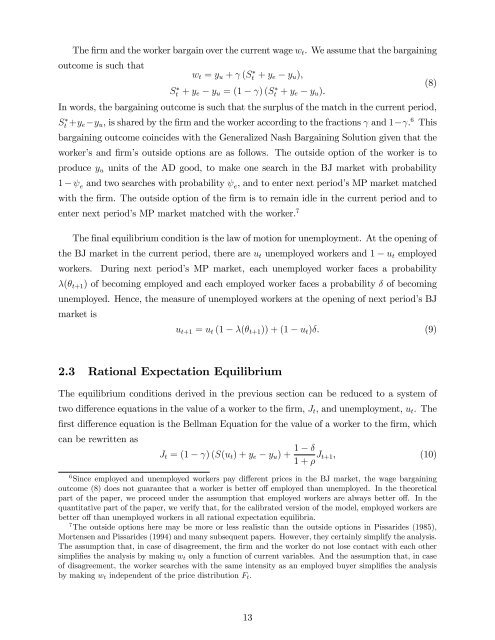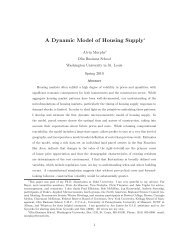Shopping Externalities and Self Fulfilling Unemployment Fluctuations*
Shopping Externalities and Self Fulfilling Unemployment Fluctuations*
Shopping Externalities and Self Fulfilling Unemployment Fluctuations*
Create successful ePaper yourself
Turn your PDF publications into a flip-book with our unique Google optimized e-Paper software.
The …rm <strong>and</strong> the worker bargain over the current wage w t . We assume that the bargainingoutcome is such thatw t = y u + (St + y e y u ),(8)St + y e y u = (1 ) (St + y e y u ).In words, the bargaining outcome is such that the surplus of the match in the current period,St +y e y u , is shared by the …rm <strong>and</strong> the worker according to the fractions <strong>and</strong> 1 . 6 Thisbargaining outcome coincides with the Generalized Nash Bargaining Solution given that theworker’s <strong>and</strong> …rm’s outside options are as follows. The outside option of the worker is toproduce y u units of the AD good, to make one search in the BJ market with probability1 e <strong>and</strong> two searches with probability e , <strong>and</strong> to enter next period’s MP market matchedwith the …rm. The outside option of the …rm is to remain idle in the current period <strong>and</strong> toenter next period’s MP market matched with the worker. 7The …nal equilibrium condition is the law of motion for unemployment. At the opening ofthe BJ market in the current period, there are u t unemployed workers <strong>and</strong> 1 u t employedworkers. During next period’s MP market, each unemployed worker faces a probability( t+1 ) of becoming employed <strong>and</strong> each employed worker faces a probability of becomingunemployed. Hence, the measure of unemployed workers at the opening of next period’s BJmarket isu t+1 = u t (1 ( t+1 )) + (1 u t ). (9)2.3 Rational Expectation EquilibriumThe equilibrium conditions derived in the previous section can be reduced to a system oftwo di¤erence equations in the value of a worker to the …rm, J t , <strong>and</strong> unemployment, u t . The…rst di¤erence equation is the Bellman Equation for the value of a worker to the …rm, whichcan be rewritten asJ t = (1 ) (S(u t ) + y e y u ) + 1 1 + J t+1, (10)6 Since employed <strong>and</strong> unemployed workers pay di¤erent prices in the BJ market, the wage bargainingoutcome (8) does not guarantee that a worker is better o¤ employed than unemployed. In the theoreticalpart of the paper, we proceed under the assumption that employed workers are always better o¤. In thequantitative part of the paper, we verify that, for the calibrated version of the model, employed workers arebetter o¤ than unemployed workers in all rational expectation equilibria.7 The outside options here may be more or less realistic than the outside options in Pissarides (1985),Mortensen <strong>and</strong> Pissarides (1994) <strong>and</strong> many subsequent papers. However, they certainly simplify the analysis.The assumption that, in case of disagreement, the …rm <strong>and</strong> the worker do not lose contact with each othersimpli…es the analysis by making w t only a function of current variables. And the assumption that, in caseof disagreement, the worker searches with the same intensity as an employed buyer simpli…es the analysisby making w t independent of the price distribution F t .13
















